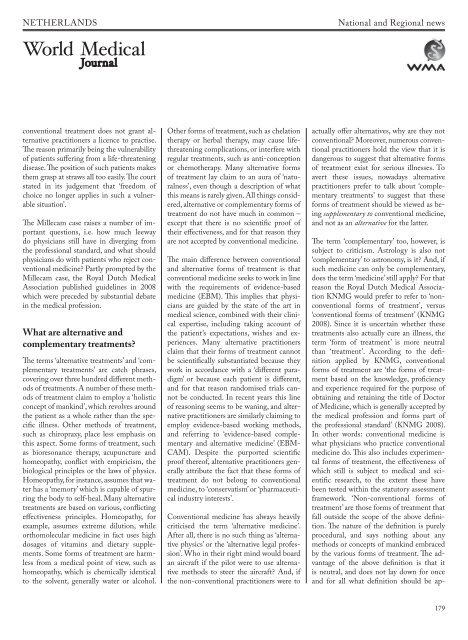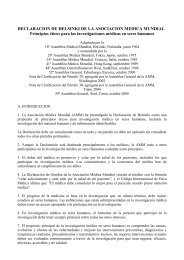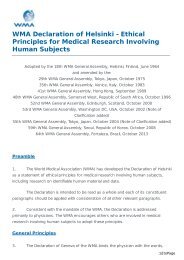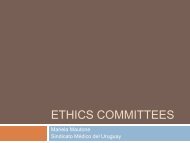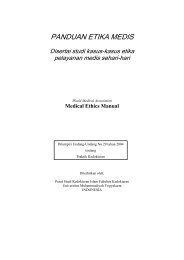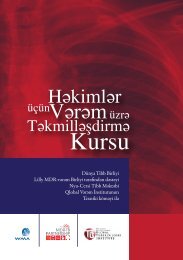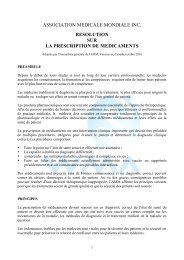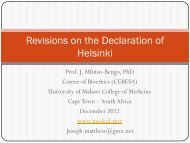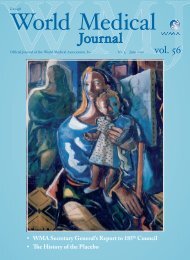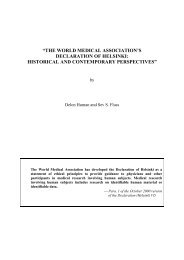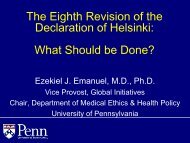WMJ 05 2011 - World Medical Association
WMJ 05 2011 - World Medical Association
WMJ 05 2011 - World Medical Association
Create successful ePaper yourself
Turn your PDF publications into a flip-book with our unique Google optimized e-Paper software.
NETHERLANDS<br />
National and Regional news<br />
conventional treatment does not grant alternative<br />
practitioners a licence to practise.<br />
The reason primarily being the vulnerability<br />
of patients suffering from a life-threatening<br />
disease. The position of such patients makes<br />
them grasp at straws all too easily. The court<br />
stated in its judgement that ‘freedom of<br />
choice no longer applies in such a vulnerable<br />
situation’.<br />
The Millecam case raises a number of important<br />
questions, i.e. how much leeway<br />
do physicians still have in diverging from<br />
the professional standard, and what should<br />
physicians do with patients who reject conventional<br />
medicine Partly prompted by the<br />
Millecam case, the Royal Dutch <strong>Medical</strong><br />
<strong>Association</strong> published guidelines in 2008<br />
which were preceded by substantial debate<br />
in the medical profession.<br />
What are alternative and<br />
complementary treatments<br />
The terms ‘alternative treatments’ and ‘complementary<br />
treatments’ are catch phrases,<br />
covering over three hundred different methods<br />
of treatments. A number of these methods<br />
of treatment claim to employ a ‘holistic<br />
concept of mankind’, which revolves around<br />
the patient as a whole rather than the specific<br />
illness. Other methods of treatment,<br />
such as chiropraxy, place less emphasis on<br />
this aspect. Some forms of treatment, such<br />
as bioresonance therapy, acupuncture and<br />
homeopathy, conflict with empiricism, the<br />
biological principles or the laws of physics.<br />
Homeopathy, for instance, assumes that water<br />
has a ‘memory’ which is capable of spurring<br />
the body to self-heal. Many alternative<br />
treatments are based on various, conflicting<br />
effectiveness principles. Homeopathy, for<br />
example, assumes extreme dilution, while<br />
orthomolecular medicine in fact uses high<br />
dosages of vitamins and dietary supplements.<br />
Some forms of treatment are harmless<br />
from a medical point of view, such as<br />
homeopathy, which is chemically identical<br />
to the solvent, generally water or alcohol.<br />
Other forms of treatment, such as chelation<br />
therapy or herbal therapy, may cause lifethreatening<br />
complications, or interfere with<br />
regular treatments, such as anti-conception<br />
or chemotherapy. Many alternative forms<br />
of treatment lay claim to an aura of ‘naturalness’,<br />
even though a description of what<br />
this means is rarely given. All things considered,<br />
alternative or complementary forms of<br />
treatment do not have much in common –<br />
except that there is no scientific proof of<br />
their effectiveness, and for that reason they<br />
are not accepted by conventional medicine.<br />
The main difference between conventional<br />
and alternative forms of treatment is that<br />
conventional medicine seeks to work in line<br />
with the requirements of evidence-based<br />
medicine (EBM). This implies that physicians<br />
are guided by the state of the art in<br />
medical science, combined with their clinical<br />
expertise, including taking account of<br />
the patient’s expectations, wishes and experiences.<br />
Many alternative practitioners<br />
claim that their forms of treatment cannot<br />
be scientifically substantiated because they<br />
work in accordance with a ‘different paradigm’<br />
or because each patient is different,<br />
and for that reason randomised trials cannot<br />
be conducted. In recent years this line<br />
of reasoning seems to be waning, and alternative<br />
practitioners are similarly claiming to<br />
employ evidence-based working methods,<br />
and referring to ‘evidence-based complementary<br />
and alternative medicine’ (EBM-<br />
CAM). Despite the purported scientific<br />
proof thereof, alternative practitioners generally<br />
attribute the fact that these forms of<br />
treatment do not belong to conventional<br />
medicine, to ‘conservatism’ or ‘pharmaceutical<br />
industry interests’.<br />
Conventional medicine has always heavily<br />
criticised the term ‘alternative medicine’.<br />
After all, there is no such thing as ‘alternative<br />
physics’ or the ‘alternative legal profession’.<br />
Who in their right mind would board<br />
an aircraft if the pilot were to use alternative<br />
methods to steer the aircraft And, if<br />
the non-conventional practitioners were to<br />
actually offer alternatives, why are they not<br />
conventional Moreover, numerous conventional<br />
practitioners hold the view that it is<br />
dangerous to suggest that alternative forms<br />
of treatment exist for serious illnesses. To<br />
avert these issues, nowadays alternative<br />
practitioners prefer to talk about ‘complementary<br />
treatments’ to suggest that these<br />
forms of treatment should be viewed as being<br />
supplementary to conventional medicine,<br />
and not as an alternative for the latter.<br />
The term ‘complementary’ too, however, is<br />
subject to criticism. Astrology is also not<br />
‘complementary’ to astronomy, is it And, if<br />
such medicine can only be complementary,<br />
does the term ‘medicine’ still apply For that<br />
reason the Royal Dutch <strong>Medical</strong> <strong>Association</strong><br />
KNMG would prefer to refer to ‘nonconventional<br />
forms of treatment’, versus<br />
‘conventional forms of treatment’ (KNMG<br />
2008). Since it is uncertain whether these<br />
treatments also actually cure an illness, the<br />
term ‘form of treatment’ is more neutral<br />
than ‘treatment’. According to the definition<br />
applied by KNMG, conventional<br />
forms of treatment are ‘the forms of treatment<br />
based on the knowledge, proficiency<br />
and experience required for the purpose of<br />
obtaining and retaining the title of Doctor<br />
of Medicine, which is generally accepted by<br />
the medical profession and forms part of<br />
the professional standard’ (KNMG 2008).<br />
In other words: conventional medicine is<br />
what physicians who practice conventional<br />
medicine do. This also includes experimental<br />
forms of treatment, the effectiveness of<br />
which still is subject to medical and scientific<br />
research, to the extent these have<br />
been tested within the statutory assessment<br />
framework. ‘Non-conventional forms of<br />
treatment’ are those forms of treatment that<br />
fall outside the scope of the above definition.<br />
The nature of the definition is purely<br />
procedural, and says nothing about any<br />
methods or concepts of mankind embraced<br />
by the various forms of treatment. The advantage<br />
of the above definition is that it<br />
is neutral, and does not lay down for once<br />
and for all what definition should be ap-<br />
179


